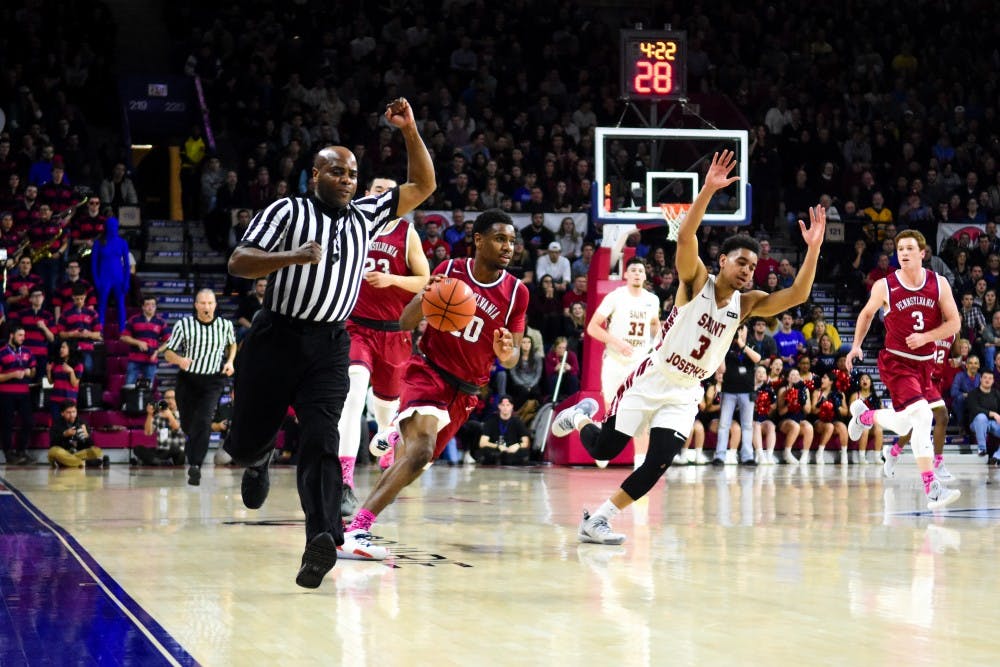
Freshman guard Bryce Washington has asserted himself as one of the best sharpshooters both for the Quakers and in the Ivy League with a mark of .417 from beyond the arc.
Credit: Alexa CotlerJust over halfway through the Ivy League slate, Penn men’s basketball finds itself on the outside looking in. The Princeton sweep and splitting three consecutive Ivy weekends has put the Quakers two games behind fourth place at 3-5.
In December, it didn’t take much to be an optimistic fan of Penn men’s basketball. The Quakers — in a phrase repeated over and over as Ivy League mediocrity has continued — beat a Power Five Miami (Fla.) and a ranked Villanova team. Any team that sweeps the Big 5 is seemingly a lock for some sort of postseason play at the very least, no?
If the Penn season has been a rollercoaster, this was the high point. Penn was justifiably receiving votes in the AP Top 25 Poll, and the thought was that if Ivy play went as well as the Big 5, maybe the Red and Blue would have a shot at an at-large bid to the NCAA Tournament. Since then, it has been a downhill ride — bad losses to Toledo and Monmouth followed up by an 0-3 Ivy League start.
With three weekends left to play, there seem to be three camps with different visions for how the remainder of the season will play out. Let’s take a look at some of the more likely possibilities.
The optimist’s prediction
Coach Steve Donahue’s team has the pieces to extend its season to late March. All it takes is a return to the form of December. But what would that look like?
Penn’s three-point shooting would have to improve in both absolute terms and in consistency. Penn has shot 40.9 percent from beyond the arc in wins, but just 27.9 percent in losses. The magic number seems to be 35 percent: The Quakers are 13-1 this season when they shoot at or above that rate.
The other x-factor is, of course, freshman forward Michael Wang. Wang started the season off strong — making four treys in the season opener and drawing attention even when he wasn’t scoring. And for the most part, he was scoring, even in limited minutes to start the season. He did his best work against Penn’s toughest nonconference opponents, scoring double digit points against No. 12 Kansas State, Miami, and No. 17 Villanova. Since an injury against Toledo, he hasn’t been able to reach that same level as often, but when he has, he has given the Quakers’ offense the boost it needed.
An optimistic fan would say that both Penn and Wang can be consistently as good as they were at their best. If that fan is right, Wang and hot shooting will carry Penn to five or six wins in their remaining six games and make the Ivy League Tournament. The Quakers still could peak at the right time and find themselves in the NCAA Tournament after all.

The pessimist’s prediction
Not all fans believe such a rosy outlook is possible. There are some that argue that what we can expect is what we've been getting in early January and parts of February: bad.
You could point to the turnover problem, lack of depth, cold-shooting, or inexperience. There are parts of this team that are not as good as fans had hoped before the season or even in December. Those weaknesses could easily prevent the Quakers from making it to the Ivy Tournament.
A pessimist would say that Penn has no chance of even reaching .500 in the conference; that would require a weekend sweep, something the Quakers have yet to accomplish. It would also require Penn to beat a team it lost to the first time around, a tall order particularly where conference-leading Yale and Harvard are concerned.
In this view, Penn’s inconsistent shooting from outside would allow defenses to collapse on the Red and Blue’s biggest threat: forward AJ Brodeur. With Brodeur facing constant double teams and his teammates unable to take advantage, Penn’s offense will grind to a halt. Even getting to the line would be no respite; the free-throw problem of the last few years would rear its ugly head and cost Penn needed wins.
The pessimistic take has the Quakers plodding along to a disappointing four- or five-win Ivy season and a less than graceful fall from postseason consideration.
The realist’s prediction
Somewhere between those two extremes is the likeliest scenario — Penn wins four of its remaining six games and leaves its future in the hands of its fellow Ivies. A seven-win Penn team would have to rely on either Cornell or Princeton ending their season with just one win in six tries or a Brown resurgence.
As it stands, Penn is 3-5 and two games behind Princeton and Cornell, both of whom own tiebreakers over the Quakers. Assuming the Tigers and Big Red continue their recent winning trends, Penn’s path to making the Ivy Tournament would require seven or even eight wins. A tie at 7-7 could be enough to get the Quakers into the Tournament if Brown (who is also 3-5) was also involved in the tie. In that scenario, Penn’s 2-0 record against the Bears — all but necessary for the Quakers to reach seven wins — would serve as a tiebreaker, potentially enough to clinch a trip to New Haven, Conn.
However, Brown is a strong team, and Princeton and Cornell both have exploitable weaknesses. Stealing a game from Harvard or Yale is hardly out of the question and would do wonders for Penn’s tiebreaker scenarios. Penn’s Ivy losses have been tight — two have come in overtime, and the Quakers were one Bryce Aiken miss away from beating Harvard.
Playing with desperation can have a tangible effect on a game. The advanced statistics, including kenpom, rate Penn third in the conference, above Cornell, Brown and Princeton.
It seems reasonable to expect Penn to steal a game or two and sneak into the Tournament even while playing the same basketball it has been playing. It seems just as reasonable that they'll fall just short.

THEODOROS PAPAZEKOS is a College junior from Pittsburgh and Senior Sports Editor for The Daily Pennsylvanian. He can be reached at papazekos@thedp.com.
The Daily Pennsylvanian is an independent, student-run newspaper. Please consider making a donation to support the coverage that shapes the University. Your generosity ensures a future of strong journalism at Penn.
Donate






